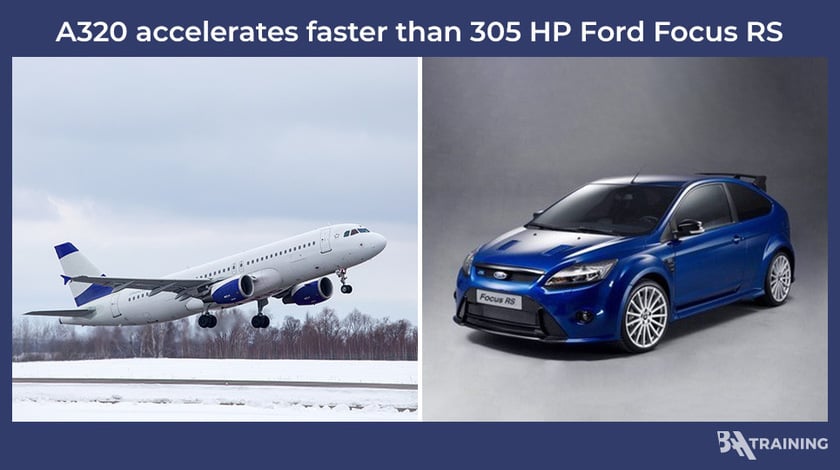Photo: BAA Training
Reading Time: 4 minutesFly-by-wire technology, side-stick controls and cockpit commonality in commercial aircraft all together form a paradise called Airbus A320 Family. Nevertheless, in a world where freedom of choice and diversity of options are more available than ever, it’s easy to get lost. After all, besides Airbus, there’re many other successful aircraft manufacturers, such as Bombardier, ATR, Embraer and, obviously, the biggest Airbus’s rival – Boeing. Still, Airbus A320 Family is topping the rankings and has something exceptional to offer. Regardless of whether you are an A320 pilot, pilot to-be or are looking into Type Rating options, check the facts and figures below that will assure you that A320 Family is close to unconquerable.
1. 15,578 orders and 9,709 deliveries as of April 2021.
As of April 2021, Airbus reports 15,578 Airbus A320 Family aircraft orders from over 300 worldwide customers. Deliveries stand at 9,709 and backlog – at 5,869. Although both 2019 and 2020 have made aircraft manufacturers vulnerable, Airbus has still shown outstanding results compared to other plane makers. In 2020, it had a 66.8% share of 825 aircraft deliveries, leaving Boeing behind at 18.7%. The breakdown did not differ substantially from the year before when Airbus hit a 59.5% mark, and Boeing accounted for 25.9% of the total of 1456 deliveries. Notably, most of the above deliveries in 2019-2020 were Airbus A320 Family airplanes – 419 out of 551 in 2020 and 636 out of 867 in 2019.

2. An A320 Family aircraft takes off and lands every 2 seconds.
We can compare the frequency of A320 family aircraft taking off and touch down to blinking or breathing. Although it may sound like a fun or even fictive fact, Airbus has explained how it did the Math: “We took the total number of take offs and landings in 2018 – 25,653,168 – and divided it down to reveal that there are 0.81 take offs and landings per second, meaning there’s one every 1.23 seconds. Given new aircraft are delivered every day, we rounded down.” So although a lot has happened since 2018, and the statistics might have shrunk a bit, there is still a fair chance that whenever you see a white trail in the sky, it’s an A320 Family airliner that left it.
3. A320neo offers 4-6% lower fuel burn per seat compared to the Boeing 737 MAX8.
Airlines strive to conserve fuel since they can trim costs by using enhanced fuel efficiency solutions given the high oil price. A slight 1% reduction in the average fuel burn per annum of an Airbus A320 leads to 100 tonnes of fuel not burnt, over €40,000 in cost savings to the operators. A320neo ensures 4-6% lower fuel burn per seat compared to the Boeing 737 MAX8, according to Airbus. A321neo offers a 7% lower fuel burn per seat compared to the Boeing 737 MAX10.
4. At the end of its operational life, 85% of an A320 can be recycled.
Airbus aims for sustainability and is making considerable progress in identifying and promoting the recycling of aircraft and their components. At the end of its lifecycle, approximately 85% of an A320 can be efficiently recycled in terms of weight. The company’s target, however, is 95%. In addition, the EU has the second-largest market for aircraft leaving service, so the recycling opportunity there is also high, worth about €80M per year. In 2015, Airbus estimated that over 4,000 aircraft would be retired by 2023 at a rate of over 200 aircraft per year. So having components that can be easily recycled, reused or otherwise recovered is extremely important.
5. Airbus A320 Family has one of the lowest crash rates.
According to Forbes, Airbus A320 family aircraft have a clean flight record and are known for being the safest airplanes. This family has a 0.08 crash rate, one of the lowest for airplane models with a crash history. Additionally, as Boing reports, fourth-generation aircraft have the lowest accident rate of all. In 2020, the fourth-generation fatal accident rate was 0.04 accidents per million flight cycles. It was approximately a third of the rate for third-generation aircraft.
6. The A320 can accelerate from 0 to 200 km/h in less than 20 seconds.
It’s always easier to grasp some numerical information when you visualize it compared to something well-known or, at least, something easy to imagine. The A320 can accelerate from 0 to 200 km/h in less than 20 seconds – faster than 305 HP Ford Focus RS. The turbocharged vehicle known for its speedy acceleration capability reaches 200 km/h in 22,9 s. New-generation engine options Airbus offers to choose from are Pratt & Whitney’s PurePower PW1100G-JM geared turbofan and CFM International’s LEAP-1A.

Hopefully, this brief overview has shed some light on what type of company Airbus is and what you can expect from its famous Airbus A320 Family. If your current target is gaining a Type Rating, obviously, you are interested in choosing a type that your future employer flies. As of March 2021, there were 9,247 A320 family aircraft in commercial service with over 330 operators. That makes a pretty high chance that with A320 Type Rating handy, you will be choosing your employer and not vice versa. BAA Training can help you get to this point faster – register for A320 Type Rating training in Vilnius, Lithuania or Barcelona, Spain and get one step closer to the flight deck of a commercial airliner. If not convinced just yet, you may want to continue your research with the article Which Type Rating to choose: Boeing 737 or Airbus A320?.

